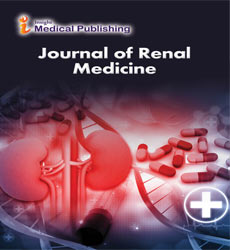The Use of Biochemical Markers to Predict Irreversible Kidney Damage in Chronic Kidney Disease
Young Chang*
Department of Internal Medicine, Yonsei University, Seoul, Republic of Korea
- *Corresponding Author:
- Young Chang
Department of Internal Medicine, Yonsei University, Seoul,
Republic of Korea,
E-mail: chang@hotmail.com
Received date: June 14, 2024, Manuscript No. IPJRM-24-19500; Editor assigned date: June 17, 2024, PreQC No. IPJRM-24-19500 (PQ); Reviewed date: July 01, 2024, QC No. IPJRM-24-19500; Revised date: July 08, 2024, Manuscript No. IPJRM-24-19500 (R); Published date: July 15, 2024, DOI: 10.36648/ipjrm.7.4.33
Citation: Chang Y (2024) The Use of Biochemical Markers to Predict Irreversible Kidney Damage in Chronic Kidney Disease. Jour Ren Med Vol.7 No. 4: 33.
Description
The prevalent condition known as Chronic Kidney Disease (CKD) has a significant impact on the patient as well as their immediate surroundings and places a significant strain on the healthcare system. Kidney Disease Improving Global Outcomes (KDIGO) rules suggest that Glomerular Filtration Rate (GFR) estimation or assessment is a basic indicative device for CKD. In order to stop the progression of the disease and reduce the likelihood of adverse outcomes, early diagnosis and treatment of CKD are essential. Precise GFR evaluation is basic in such manner, as it gives significant data about the seriousness and movement of CKD. The estimation or measurement of GFR is an essential component of clinical practice guidelines and widely recognized as important in the diagnosis and treatment of CKD. Numerous illnesses and possibly harmful harming specialists assume a part in CKD improvement. However, several biochemical markers can be used to predict that irreversible damage to the glomeruli and tubules will occur during the pathogenesis of CKD.
Phase of Chronic Kidney Disease (CKD)
In the underlying phase of Chronic Kidney Disease (CKD), albuminuria is the most promptly accessible and best normalized urinary biomarker and is practical with pee dipstick techniques. Albuminuria increases cardiovascular risk and is a CKD predictor. Consequently, it is suggested that proteinuria levels be partitioned into stages. Cardiovascular gamble likewise relies upon the proteinuria level. Abnormal kidney function that persists for at least three months and abnormal albuminuria that is detected despite normal kidney function can both be used to diagnose chronic kidney damage. Abnormalities in the kidney's structure or morphology are another sign of CKD. It has been determined that a significant factor in the gradual narrowing of the Glomerular Filtration Rate (GFR) is a gradual decrease in the number of nephrons. A patient's serum creatinine levels can be used to estimate their eGFR in clinical practice. Cystatin C, a marker that passes freely through the kidneys and is not reabsorbed, can be measured in the serum in a different way. The patient's creatinine clearance is strongly correlated with the serum level of cystatin C. In situations where a patient's eGFR esteem is ridiculously underrated, and there is no obvious kidney harm, the cystatin C level ought not entirely set in stone. This is especially crucial when the patient is at risk for chronic kidney disease or albuminuria, as well as when these conditions are suspected. The total impact of these cycles in the end sets off an endless loop that further disables kidney capability. Renal function gradually declines as CKD progresses. Patients with severely advanced and untreated kidney damage exhibit typical uremic symptoms. Alongside the slow decay of kidney capability, many going with clinical side effects can be seen because of weakened physiological capability of the kidneys.
International guidelines of CKD
International guidelines have been rewritten as a result of the new drug therapies for Chronic Kidney Disease (CKD) that have recently been introduced. The significance of combining these new pharmacological interventions with established therapeutic modalities that are both cost-effective and effective is emphasized in our comprehensive narrative review. It is basic to perceive that a diverse way to deal with CKD the board is fundamental for ideal patient results. Nephrological care includes two urgent undertakings they are forestalling Chronic Kidney Disease (CKD) and easing back its movement. People with CKD have a fundamentally higher gamble of horribleness and mortality from cardiovascular illness, whether or not they have diabetes or hypertension. In addition, the risk of death from CKD, particularly from cardiovascular diseases, is higher than the threshold necessary to begin renal replacement therapy. Thusly, it is basic to forestall kidney illness and encourage the movement of CKD. Tending to the basic circumstances that cause CKD is vital for easing back its movement. For instance, hematological conditions, diabetes, hypertension, primary glomerular diseases, and Autosomal Polycystic Kidney Disease (ADPKD) should be treated. The quickest way to halt the progression of kidney disease is to promptly address reversible processes, such as possible obstruction of the urine flow.
Open Access Journals
- Aquaculture & Veterinary Science
- Chemistry & Chemical Sciences
- Clinical Sciences
- Engineering
- General Science
- Genetics & Molecular Biology
- Health Care & Nursing
- Immunology & Microbiology
- Materials Science
- Mathematics & Physics
- Medical Sciences
- Neurology & Psychiatry
- Oncology & Cancer Science
- Pharmaceutical Sciences
